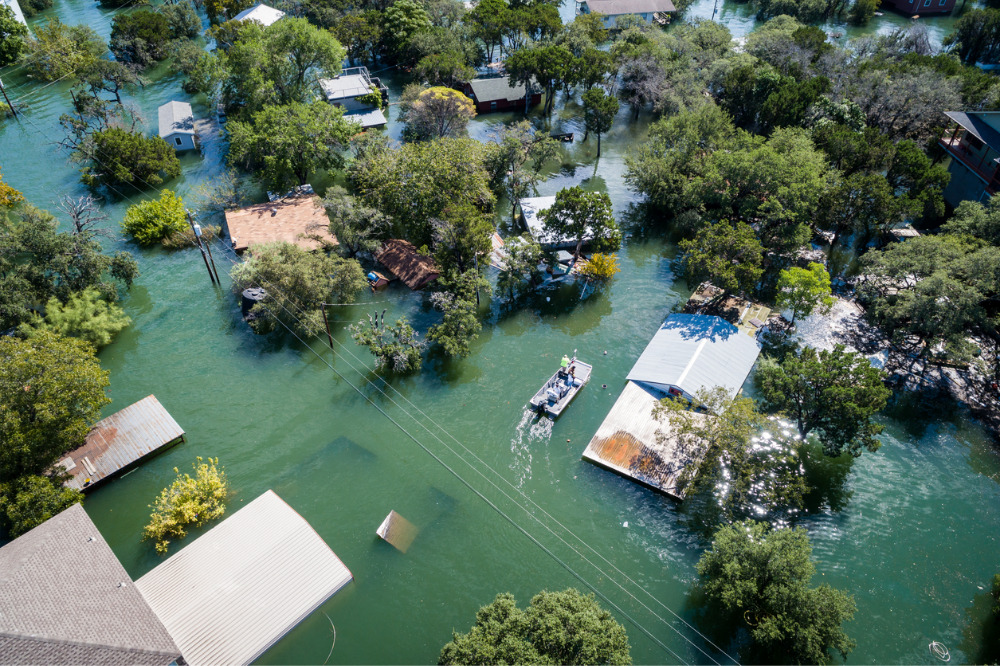What was the most frequently occurring natural peril in 2021?

The major drivers of insured losses in 2021 were secondary perils, including floods, wildfires, and severe storms. Flooding was by far the most frequently occurring natural peril in 2021, accounting for 31% of global economic losses from natural catastrophes, only 2% less than hurricanes. Notably, only 25% of global economic losses from major flood events were insured in 2021, indicating a global protection gap for the most commonly occurring risk that affects more than a third of the global population.
Read next: Is the insurance industry prepared to handle earthquakes?
“As we look at the sigma data from 2021, the most prominent item […] is really the flood losses. What we’ve revealed is that extreme flood events in 2021 yet again drove significantly high losses, but also there was a dramatic under-insurance gap, [where] 75% of flood risks remained uninsured in 2021,” said Mike Mitchell, head of property and specialty (P&S) underwriting reinsurance at Swiss Re.
“The global economic losses from floods amounted to $82 billion, and the insured loss contribution to that was a mere $20 billion, which simply underlines the opportunities in the space, but also the challenges that we face as an industry. Despite record-level insured losses from floods, the associated global protection gap remains a challenge for us that is just simply too large.”
Mitchell has over 30 years of reinsurance industry experience in both underwriting and client management roles. He has led cross functional teams on a global level for Swiss Re, and has lived in London, Singapore, Melbourne, and Sydney. He took his current role as head of P&S underwriting reinsurance in 2017, and, since then, has seen some very significant shifts in nat cat loss trends and patterns.
“It’s actually quite poignant for me that I started working in the role … in 2017, when some of the things that we’ve been tracking and anticipating in respect of the emergence of secondary perils and climate-related loss activity really started to bite in a serious way,” said Mitchell. “For the period from 2017 through to today, we’ve really witnessed quite an extreme shift in terms of loss patterns and activities in a space which is clearly much more associated with climate.”
In North America, the impacts of climate change are growing clearer every year. In 2021, the US suffered hurricanes, tornadoes and thunderstorms, wildfires, extreme heat and extreme cold.
“Hurricane Ida was the costliest natural disaster of the year, which battered the south of the US with Cat 4 force winds in August, but then tracked Northeast where the intense rainfall brought significant flooding to the New York City metropolitan area, among other regions. Ida is a reminder of the loss potential of primary perils striking densely populated areas,” Mitchell commented. “It only takes one event to push insurance losses for a year significantly higher. Hurricane risk is a major threat to US coastal businesses and residents and a capital driver or peak peril for the reinsurance industry.
“What was unique about Ida is that the remnants of the storm added a secondary peril loss which, through severe floods and tornadoes in the mid-Atlantic and northeast regions, generated a significant additional loss burden. The heavy precipitation that accompanies a hurricane often results in major flooding that can impact regions far from the landfall, and long after the winds have subsided.”
Read more: What are the costliest natural catastrophes in the US?
During the summer months, there was an historic stretch of record-shattering temperatures in the Northeast US and Western Canada. At the end of June, a ‘heat dome’ – a weather phenomenon whereby high-pressure conditions trap air blowing in from the Pacific Ocean – set a new all-time Canadian temperature high of nearly 50C in Lytton, British Columbia. Meanwhile, temperatures in Death Valley, California reached 54.4C during one of multiple heat waves in the southwest.
The exceptional heat was often accompanied by devastating wildfires, but, compared to recent years, the fires encroached areas of lower property concentration, triggering below average insured claims, Mitchell explained. However, insured losses for wildfire events in 2021 still exceeded $4 billion in North America.
“Fire, associated with climate change, is an ever-present hazard in North America,” Mitchell added. “Losses are likely to continue to grow in the years to come, mostly driven by rising exposures in areas of wild urban interface, multi-year droughts in the US where most of the losses originate, and often suboptimal fire management strategies that increase biomass fuels on the ground, but also some hazard intensification in some regions in the world.
“California-wide increases in autumn temperatures and decreases in autumn precipitation have led to more than doubling of the annual number of days with higher fire risk since the 1980s. And longer fire seasons in an increasingly warmer planet, happened in the closing of the year and increased the risk of costly wildfire seasons.”
Like the US, Canada is heavily affected by a wide variety of secondary perils, and the severity of these perils has increased over the years thanks to socio-economic factors and urbanization increasing exposure in high-risk areas.
“The risks from climate change in Canada have become visible,” Mitchell emphasized. “Wildfires, storms, floods, and weather extremes are exacerbated by the warming planet, putting more and more people and assets in harm’s way. We live, we build, and we work in areas most at risk – cities and towns along the coasts, near rivers, forests, or wildlands.
We have high risk areas in the country, and a public-private government solution is perhaps what is needed as the insurance industry struggles to keep up with the increasing demand the increasing prevalence that’s generated by these strange loss events.”






